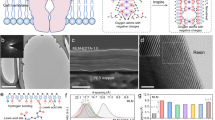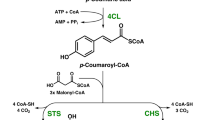Abstract
Sphingomonas sp. A1 possesses specialized membrane structures termed 'superchannels' that enable the direct incorporation of macromolecules into the cell. We have engineered two related sphingomonads, the dioxin-degrading S. wittichii RW1 and the polypropylene glycol–degrading S. subarctica IFO 16058T, to incorporate this superchannel into their cell membranes. In both cases the bioremediation capability of the organisms was substantially increased pointing at the potential of this approach as a general strategy to improve bacterial degradation of hazardous compounds in the environment.
This is a preview of subscription content, access via your institution
Access options
Subscribe to this journal
Receive 12 print issues and online access
$209.00 per year
only $17.42 per issue
Buy this article
- Purchase on Springer Link
- Instant access to full article PDF
Prices may be subject to local taxes which are calculated during checkout

Similar content being viewed by others
References
Hong, H.B. et al. Appl. Environ. Microbiol. 68, 2584–2588 (2002).
Wittich, R.M. Appl. Microbiol. Biotechnol. 49, 489–499 (1998).
Kawahara, K., Uchida, K. & Aida, K. Biochim. Biophys. Acta 712, 571–575 (1982).
Hashimoto, W. et al. Biosci. Biotechnol. Biochem. 69, 673–692 (2005).
Hashimoto, W. et al. Biochemistry 44, 13783–13794 (2005).
Hisano, T. et al. Biochem. Biophys. Res. Commun. 220, 979–982 (1996).
Mishima, Y. et al. J. Biol. Chem. 278, 6552–6559 (2003).
Momma, K. et al. J. Mol. Biol. 316, 1051–1059 (2002).
Momma, K. et al. Biochemistry 44, 5053–5064 (2005).
Momma, K. et al. J. Bacteriol. 182, 3998–4004 (2000).
Hashimoto, W. et al. J. Bacteriol. 182, 4572–4577 (2000).
Yoon, H.J. et al. Protein Expr. Purif. 19, 84–90 (2000).
Wittich, R.M. et al. Appl. Environ. Microbiol. 58, 1005–1010 (1992).
Kimbara, K. et al. J. Bacteriol. 171, 2740–2747 (1989).
Déziel, E., Comeau, Y. & Villemur, R. Biodegradation 10, 219–233 (1999).
Acknowledgements
This work was supported in part by Grants-in-Aid from the Ministry of Education, Science, Sports and Culture of Japan (10556017, 10145229, 11132237, 11460039 and 09876026 to K. Murata). This work was also supported in part by the Program for Promotion of Basic Research Activities for Innovative Biosciences (PROBRAIN) of Japan.
Author information
Authors and Affiliations
Corresponding author
Ethics declarations
Competing interests
The authors declare no competing financial interests.
Supplementary information
Supplementary Fig. 1
Overall picture of the super-channel (alginate import and depolymerization systems) in Sphingomonas sp. A1. (PDF 54 kb)
Supplementary Fig. 2
Properties of nonengineered S. wittichii RW1 (wild type). (PDF 50 kb)
Supplementary Fig. 3
Properties of the engineered dioxin-degrading sphingomonad S. wittichii RW1. (PDF 23 kb)
Supplementary Fig. 4
Western blot analysis of AlgQ2 (a) and AlgS (b) in RW1 (pKS13) and RW1 (pBE11). (PDF 27 kb)
Supplementary Fig. 5
Dibenzofuran uptake rates of the resting cells of RW1 (wild type) and RW1 (pBE11). (PDF 22 kb)
Supplementary Fig. 6
Removal of dibenzofuran from a soil inoculated with RW1 (wild type) and RW1 (pBE11). (PDF 50 kb)
Supplementary Fig. 7
Engineering of S. subarctica IFO 16058T by molecular transplantation of the super-channel. (PDF 83 kb)
Rights and permissions
About this article
Cite this article
Aso, Y., Miyamoto, Y., Mine Harada, K. et al. Engineered membrane superchannel improves bioremediation potential of dioxin-degrading bacteria. Nat Biotechnol 24, 188–189 (2006). https://doi.org/10.1038/nbt1181
Received:
Accepted:
Published:
Issue Date:
DOI: https://doi.org/10.1038/nbt1181
This article is cited by
-
Physiological role of isocitrate lyase in dibenzo-p-dioxin and dibenzofuran metabolism by Sphingomonas wittichii RW1
Journal of Genetic Engineering and Biotechnology (2022)
-
Bacterial chemotaxis towards polysaccharide pectin by pectin-binding protein
Scientific Reports (2020)
-
Production, Characterization and Bioemulsifying Activity of an Exopolysaccharide Produced by Sphingomonas sp. Isolated from Freshwater
Journal of Polymers and the Environment (2017)
-
Molecular perspectives and recent advances in microbial remediation of persistent organic pollutants
Environmental Science and Pollution Research (2016)
-
Construction of an engineered strain capable of degrading two isomeric nitrophenols via a sacB- and gfp-based markerless integration system
Applied Microbiology and Biotechnology (2014)



